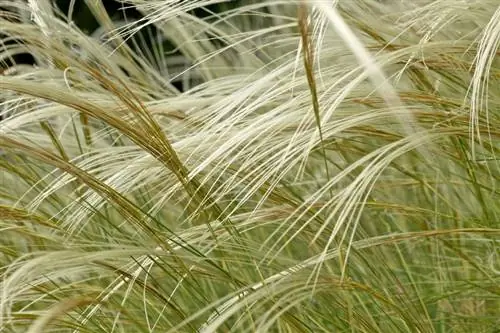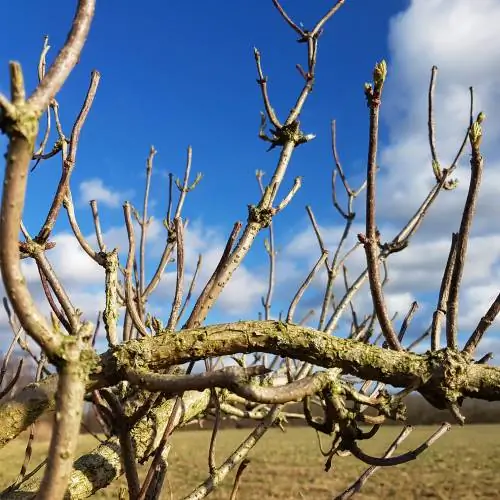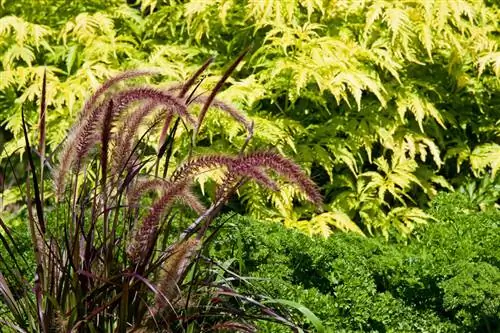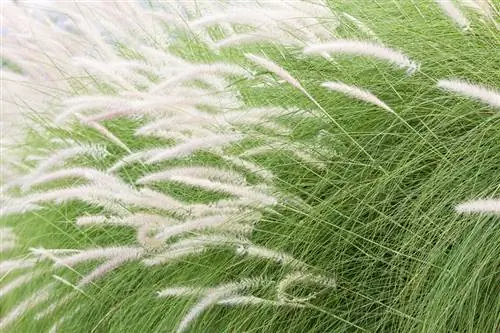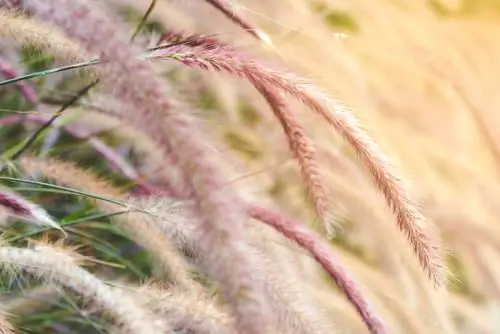- Author admin [email protected].
- Public 2023-12-25 17:45.
- Last modified 2025-01-23 11:22.
Where graceful grasses with delicate inflorescences sway gently in the summer wind, the feather grass unfolds its picturesque magic. For this natural display of splendour, Stipa would like a place in full sun in the garden. The following answers to frequently asked questions reveal what other aspects are important in cultivation.
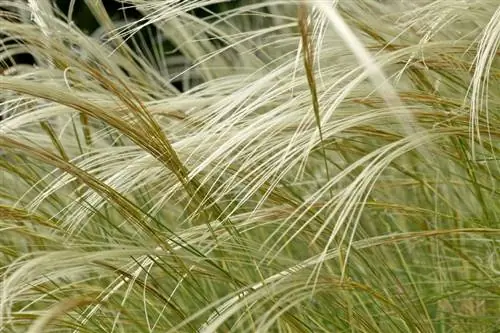
How do I care for feather grass properly?
Feather grass requires a full sun location, sandy-humus soil and moderate water supply to care for. In winter the stalks should not be cut off but tied together. Feather grass can be divided in spring and fertilized in April.
Care tips
It doesn't require extensive gardening experience to meet the frugal requirements of feather grass. How to properly care for Stipa:
- In the open field, only water with normal tap water during summer droughts
- Fertilize young feather grass in April with compost, horn shavings and some rock dust
- Tie the nest into a loose pile before the first frost
- Cover the root disc with autumn leaves or conifers
- Cut down to 10 cm above the ground in February/March or comb out with your hands
In the pot, water Stipa moderately but regularly. The delicate beauty is fertilized with diluted liquid fertilizer from April to August. In winter, cover the bucket with fleece and place it on wood. Here too, tie the ornamental grass together and only cut it off close to the ground in early spring.read more
Which location is suitable?
You can look forward to the fluffy inflorescences in summer in full sun to shady locations. The more sun the angel hair can soak up, the more luxuriantly the feathery awns will develop. Furthermore, the location should be surrounded by air and protected so that rainwater dries quickly and the winter does not cause too much damage to the clumps. A well-drained, sandy, humus-rich and lean soil guarantees vital growth.read more
The correct planting distance
The choice of an adequate planting distance largely determines the visual effect of feather grass. To ensure that the desired, airy, light appearance is visible, these distances are correct:
- Giant feather grass: 70-80 cm
- Heron feather grass and tufted feather grass: 50-60 cm
- Angel hair and fluffy feather grass: 30-40 cm
As a rule of thumb for other Stipa species, use the expected growth width as the basis for the ideal planting distance.
What soil does the plant need?
Welcome your feather grass with a loose, airy, sandy, humus-rich and nutrient-poor soil. The soil should be rich in lime and poor in water so that the magnificent feather grass feels in good hands. These soil conditions are typical in rock and steppe gardens or in sunny perennial beds with poor substrate.
When is flowering time?
Stipa develops the graceful, feathery, airy inflorescences from June to August. What is characteristic of this ornamental grass is that not all stalks sprout delicate awns. The wintergreen, dense clumps create a lush backdrop to the decorative flowers. Although the spring flowers initially visibly lose their beauty in autumn, do not cut them off. Covered with frozen hoarfrost and snow crystals, the withered awns glitter under the winter sun to create decorative accents in the otherwise empty garden.
Cut feather grass correctly
Feather grass relies on its stalks as winter protection in order to get through the cold season he althily. Therefore, do not cut off Stipa in autumn. Instead, tie the clumps together with sisal to form loose bowls so that no moisture gets inside. In February or March, cut the grass to a hand's width above the ground. The most delicate beauties, like angel hair, are only combed out with your hands.read more
Watering feather grass
Feather grass prefers sandy, dry soil and cannot tolerate waterlogging. Therefore, only water the green beauty with normal tap water when it is dry in summer. Since the substrate in the pot dries out quickly, regular watering is required in this case. If the surface dries to a depth of 2-3 cm, add water to the root ball until the first drops run out of the soil opening.
Fertilize feather grass properly
In the first 2-3 years, feather grass in the bed readily accepts organic starter fertilization in April. Add compost (€12.00 at Amazon), horn shavings or bark humus to the root disc, rake the material in lightly and then water. Only fertilize adult Stipa if there are obvious deficiency symptoms, such as pale colors or poor flowering. In pot culture, fertilize every 30 days from April to August with diluted liquid fertilizer, provided the plant has not previously been repotted into pre-fertilized substrate.
Wintering
Feather grass is well hardy. However, we recommend protection from cold moisture to protect the sensitive heart of the nest from rot. Before the first frost, tie Stipa with sisal into a loose pile. Pile up the root disc with autumn leaves or needle twigs. Never cut off awl grasses before winter, but only prune them close to the ground in February/March.
Propagate feather grass
Stipa can be propagated smoothly by division in spring. To do this, dig up the nest and place it on a solid surface. Use a spade or a knife to divide the plant into segments that have at least 3-4 shoots. At the new location, place the Stipa parts in the prepared soil and water.
In contrast, sowing proves to be complicated, time-consuming and delicate. The extremely fine seeds are cold germinators and cannot be brought to life without stratification.
Feather grass in a pot
Delicate Stipa species in pots create a dreamy ambience on the balcony and terrace. Choose a bucket with a volume of at least 5 liters and a bottom opening for water drainage. Spread pebbles or shards of clay over the top as drainage before filling in a lean, calcareous and well-drained substrate. Water moderately, as feather grass does not tolerate waterlogging. From April to August, apply a liquid fertilizer in a diluted concentration every 30 days. In winter, cover the pot with fleece or raffia mats and slide a block of wood underneath. Feather grass in pots is only cut in February/March up to 10 cm above the ground.
Which species are suitable for the garden?
The wonderful genus of feather grasses gives us several enchanting species. We have put together a selection of garden-friendly Stipa for you here:
- Fluffy feather grass (Stipa pennata): Compact type with delicate summer awns with dense clump formation; 25-50cm
- Angelhair (Stipa tenuissima): Hair-thin leaves are accompanied by silvery, later golden-yellow flowers; 30-50cm
- Tufted feather grass (Stipa capillata): Forms tightly upright, gray-green clumps with 20 cm long awns; 50-80cm
- Federspiel, heron feather grass (Stipa barbata): Elegant species with gracefully curved, feathery inflorescences from July; 50-80cm
- Giant feather grass (Stipa gigantea): Ideal for the large garden with fragrant, shiny golden awns; 60-180cm
The New Zealand feather grass (Stipa arundinacea) scores with the most beautiful autumn colors, which stands out with its golden-yellow-orange stalks.

